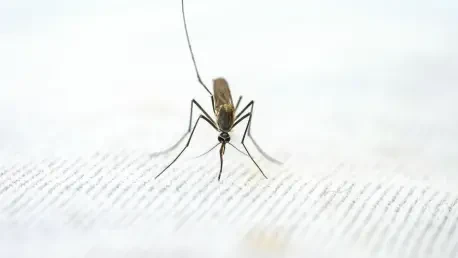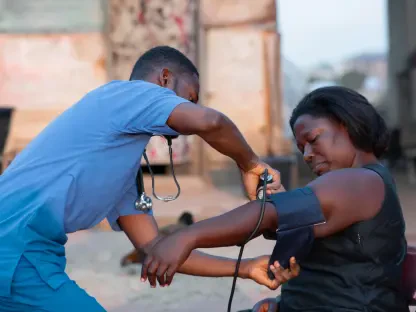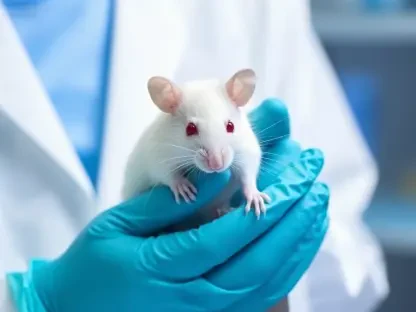In a tropical nation renowned for its vibrant culture and storied history, a silent and deadly health emergency is unfolding as Cuba grapples with the simultaneous spread of three mosquito-borne viruses—dengue, chikungunya, and Oropouche. This alarming convergence, termed “combined arboviral infections” by global health experts, is creating a public health challenge of staggering complexity. With overlapping symptoms like fever, muscle aches, and fatigue, distinguishing between these diseases without advanced testing is a nearly impossible task for medical professionals on the ground. The Cuban population faces a growing threat, compounded by systemic issues and a lack of official recognition of the full scope of this epidemic. As mosquitoes continue to thrive in the island’s warm climate, the urgency to address this multifaceted crisis has never been greater, yet the response remains fragmented and inadequate, leaving many vulnerable to severe health outcomes.
The Epidemiological Challenge
A Triple Viral Threat
The simultaneous circulation of dengue, chikungunya, and Oropouche viruses across Cuba marks a critical and unprecedented epidemiological hurdle. Transmitted primarily by mosquitoes such as Aedes aegypti and Culicoides paraensis, these viruses present a tangled web of symptoms that often mirror each other, including high fever, joint pain, and extreme tiredness. International research published in prominent journals has repeatedly warned that co-infections—where a patient contracts more than one virus—can result in significantly worse health outcomes, such as prolonged illness or even organ damage. In Cuba, however, the absence of sufficient laboratory resources to conduct differential diagnoses means that the true scale of such overlapping infections remains shrouded in uncertainty. This lack of clarity not only hampers effective treatment but also heightens the risk for communities already struggling to cope with the physical and economic toll of these diseases, painting a grim picture of an escalating public health emergency.
Beyond the immediate diagnostic challenges, the triple viral threat underscores a broader issue of preparedness in tropical regions prone to mosquito-borne diseases. The biological interactions between these viruses, as highlighted by global studies, can lead to unpredictable clinical manifestations—sometimes suppressing symptoms temporarily, only to intensify them later. For Cuban healthcare providers, this unpredictability adds another layer of difficulty to an already strained system. Without access to molecular testing or specialized reagents, doctors often rely on educated guesses to treat patients, a practice that risks misdiagnosis and inappropriate care. The situation is particularly dire in rural areas, where medical facilities are even less equipped to handle such complex cases. As mosquito populations continue to surge due to environmental factors, the potential for widespread co-infections grows, demanding an urgent and coordinated response that Cuba currently struggles to muster amid resource constraints and logistical barriers.
Unseen Dangers of Co-Infections
Delving deeper into the crisis, the hidden dangers of co-infections reveal a troubling reality for Cuba’s health landscape. Scientific evidence from tropical regions worldwide suggests that when viruses like dengue and chikungunya coexist in a single patient, the severity of symptoms can escalate, leading to complications such as internal bleeding or chronic joint pain. In some cases, the sequence of infection plays a critical role—contracting one virus after another can either dampen or amplify the body’s response, creating a medical puzzle with no easy solution. In Cuba, where confirmatory testing is scarce, these nuanced interactions go undetected, leaving patients at risk of long-term health issues. The lack of awareness among the general population further exacerbates the problem, as many fail to seek timely care, mistaking severe symptoms for a common fever, thus allowing the viruses to spread unchecked within tight-knit communities.
Moreover, the unseen dangers extend beyond individual health to the broader societal impact of these co-infections. As more people fall ill, the strain on families and local economies intensifies, with breadwinners unable to work and children missing school due to illness or caregiving responsibilities. Hospitals, already overwhelmed, become breeding grounds for frustration as patients wait for care that may not come in time. International health experts have emphasized that tackling co-infections requires not just medical intervention but also robust public education to prevent transmission. Yet, in Cuba, such initiatives are virtually nonexistent, hampered by a lack of funding and centralized coordination. The silent progression of these combined infections, invisible to both policy and public perception, continues to erode the well-being of entire regions, highlighting the urgent need for a paradigm shift in how this crisis is understood and addressed.
Systemic Failures and Government Response
Healthcare Under Strain
In the heart of Cuba’s outbreak zones, such as Matanzas, identified as a key epicenter since July, the healthcare system is buckling under the weight of this viral surge. Hospitals and clinics in regions like Cárdenas and Colón face critical shortages of basic diagnostic tools needed to identify severe cases of dengue, such as leukograms and platelet counts. Essential medications, including pain relievers and hydration solutions, are often out of stock, leaving patients to endure debilitating symptoms with little relief. Vector control measures, vital to curbing mosquito populations, are equally compromised—fumigation brigades sit idle due to insufficient fuel, insecticides, and trained personnel. This breakdown in infrastructure allows mosquitoes to proliferate, turning neighborhoods into hotspots for disease transmission and placing an unbearable burden on medical staff who struggle to provide even minimal care to an ever-growing number of patients.
The strain on healthcare extends beyond physical resources to the human element, as doctors and nurses face burnout amid the relentless wave of infections. Working without clear diagnoses, many medical professionals express frustration over their inability to offer targeted treatments, often resorting to symptomatic care that may not address the underlying virus. In rural communities, where access to hospitals is limited, the situation is even bleaker, with patients forced to travel long distances for help that may not be available upon arrival. The absence of public health campaigns means that preventive measures, such as eliminating standing water or using mosquito nets, are not widely adopted, further fueling the epidemic. This systemic collapse reveals a stark reality: without significant investment in medical supplies, personnel, and community outreach, Cuba’s ability to manage this crisis remains severely limited, risking a deeper public health catastrophe.
Official Denial and Its Consequences
Compounding the physical challenges is the Cuban government’s apparent reluctance to acknowledge the full extent of the combined viral crisis. While local doctors and residents report atypical symptoms and prolonged illnesses suggesting multiple infections, the Ministry of Public Health continues to frame the situation as isolated outbreaks, with a primary focus on dengue. Even as officials like Dr. Francisco Durán, the national director of Epidemiology, have publicly noted cases of chikungunya and suspected Oropouche infections in areas like Matanzas, the overarching narrative downplays the interconnected nature of these diseases. This fragmented approach prevents the development of unified protocols for diagnosis, isolation, and treatment, leaving healthcare workers without the guidance needed to address the epidemic holistically. The result is a disjointed response that fails to match the scale of the threat facing the population.
The consequences of this official denial ripple through every level of the health system, creating a dangerous gap between policy and reality. Without a centralized acknowledgment of combined arboviral infections, resources are not allocated effectively, and critical interventions like mass surveillance or integrated vector control remain unimplemented. This lack of transparency also erodes public trust, as communities grappling with illness receive mixed messages about the risks they face. International health organizations have long stressed that early recognition of multi-virus outbreaks is crucial for containment, yet Cuba’s delayed reporting and reluctance to adapt stifle such efforts. As the epidemic spreads across the island, the absence of a cohesive strategy rooted in reality continues to undermine any chance of curbing the crisis, leaving both medical professionals and citizens vulnerable to an escalating and poorly understood threat.
Global Insights and Local Realities
Lessons from International Research
Turning to the global stage, scientific literature offers critical insights into the severity of arboviral co-infections, particularly in tropical and resource-limited settings akin to Cuba. Studies from regions like South America and the Caribbean, published in reputable journals, reveal that when viruses such as dengue and chikungunya overlap, clinical outcomes can worsen, with patients experiencing intensified symptoms like persistent fever or severe joint pain. Research also highlights the complex biological interactions between these viruses, where the order of infection can alter the body’s immune response, sometimes leading to unexpected complications. For Cuba, these findings underscore the urgent need for comprehensive surveillance systems and advanced testing capabilities—tools that remain largely out of reach due to systemic constraints, leaving the country ill-equipped to apply these vital lessons to its own epidemic.
Furthermore, international research emphasizes the importance of proactive measures in managing multi-virus outbreaks, a stark contrast to Cuba’s current approach. Case studies from countries like Brazil and Colombia demonstrate that multipathogen surveillance, coupled with public health education, can significantly reduce transmission rates and improve patient outcomes. These strategies rely on early detection through molecular testing and community engagement to promote preventive behaviors—elements missing from Cuba’s response. The global consensus is clear: underestimating or ignoring combined infections can amplify outbreak dynamics, a warning that resonates deeply with Cuba’s situation. Without the capacity to implement such evidence-based practices, the island remains trapped in a cycle of reactive measures, unable to break free from the mounting toll of these viruses on its population and healthcare infrastructure.
Bridging the Gap with Actionable Solutions
Reflecting on the past, it became evident that Cuba had faced a profound challenge with the unchecked spread of dengue, chikungunya, and Oropouche viruses, a crisis deepened by institutional silence and resource scarcity. Looking back, the fragmented response from authorities had hindered the ability to curb the epidemic, as official narratives failed to align with the reality experienced by doctors and communities. The strain on hospitals, the absence of diagnostic tools, and the inconsistent vector control efforts had painted a dire picture of a system overwhelmed by a triple viral threat. International research had provided clear warnings about the dangers of co-infections, yet the lack of capacity to act on these insights had left the population vulnerable to severe health consequences, a sobering reminder of the cost of inaction in the face of such complex public health emergencies.
Moving forward, actionable steps must be prioritized to address the lingering effects of this crisis and prevent future outbreaks. Investment in diagnostic infrastructure, including accessible testing kits and laboratory equipment, should be a cornerstone of reform to ensure accurate identification of viruses. Strengthening vector control through consistent fumigation and community-driven initiatives to eliminate mosquito breeding sites offers a practical path to reducing transmission. Additionally, transparent communication from health authorities, acknowledging the full scope of arboviral threats, can rebuild trust and enable the development of unified treatment protocols. Partnering with international health organizations to access resources and expertise could further bolster Cuba’s capacity to implement multipathogen surveillance. These measures, rooted in lessons from the past, provide a roadmap for safeguarding public health and ensuring that such a devastating epidemic does not recur with the same unchecked ferocity.









